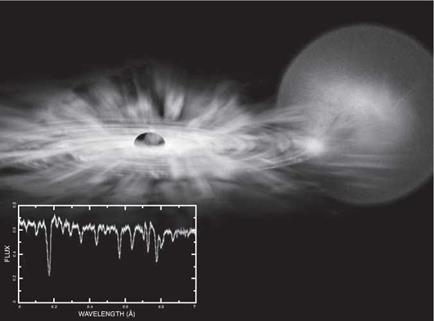Heart of Darkness
Black holes are black. That seems like a self-evident statement. Nothing can escape the event horizon of a black hole; the event horizon isn’t a physical barrier or a boundary but an information membrane, defining the region from which no particle or radiation can escape. Black holes are the ultimate expressions of general relativity, where mass curves space so much that a region is pinched off from view.28
Black holes are the final states of massive stars. Every star is in a life-long battle between the forces of light and darkness. The light comes from fusion reactions creating pressure that pushes outward, while the dark is the implacable force of gravity pulling inward. In the end gravity always wins. When a star twenty or more times the Sun’s mass exhausts its nuclear fuel, the core collapses into a state so dense that nothing can escape, not even light. An isolated black hole would be black and undetectable. However, more than half of all stars are in binary or multiple systems, and that’s also true of the most massive stars that collapse catastrophically when their nuclear fuel is exhausted, forming a black hole. The rotation of the star is amplified in its newly compact state, so the black hole spins very fast. As material from a companion star is pulled onto the black hole, it forms a disk of gas, like water swirling into the drain of a bathtub.29 The disk is very hot, tens of thousands of degrees, and it glows in ultraviolet radiation and X-rays. Some hot plasma is accelerated along the pole of the spinning black hole, where it emits X-rays and gamma rays. So while a black hole is black, gas from a companion can be heated into pyrotechnic activity when it’s falling into the black hole (figure 10.2). The accretion process is well enough understood theoretically that X-ray signatures can be used to identify black holes. Some of the radiation comes from no more than 100 kilometers from the event horizon. The Chandra Observatory has played a vital role in this work.30
Chandra has the sensitivity to detect stellar black holes hundreds of light-years away. Only about twenty binary systems have well-enough measured masses to be sure the dark companion is a black hole, but X-ray observations can be used to identify black
|
Figure 10.2. Black holes do not emit any energy or particles, but when a black hole is part of a binary system, gas is drawn from the companion onto an accretion disk that glows in X-rays. The binary orbit gives the mass of the black hole. The image is an artist’s impression, while the inset shows an X-ray spectrum which diagnoses the temperature of the plasma near the black hole and gives clues to the black hole’s properties (NASA/CXC/M. Weiss/J. Miller). |
holes with fairly high reliability. The examples studied with X – ray telescopes are the brightest representatives of a population of about 100 million black holes in the Milky Way.31
X-ray observations have also pushed the limit of our understanding of black holes. In 2007, a research team used Chandra to discover a black hole in M33, a nearby spiral galaxy. The black hole was sixteen times the mass of the Sun, making it the most massive stellar black hole known.32 Moreover, it was in a binary orbit with a huge star seventy times the Sun’s mass. The formation mechanism of the black hole that placed it in such a tight embrace with its companion is unknown. This is the first black hole in a binary system that shows eclipses, which provides unusually accurate measurements of mass and other properties. The massive companion will also die as a black hole, so future astronomers will be able to gaze on a binary black hole where energy is lost as gravitational radiation and the two black holes dance a death spiral as they coalesce into a single beast.33











